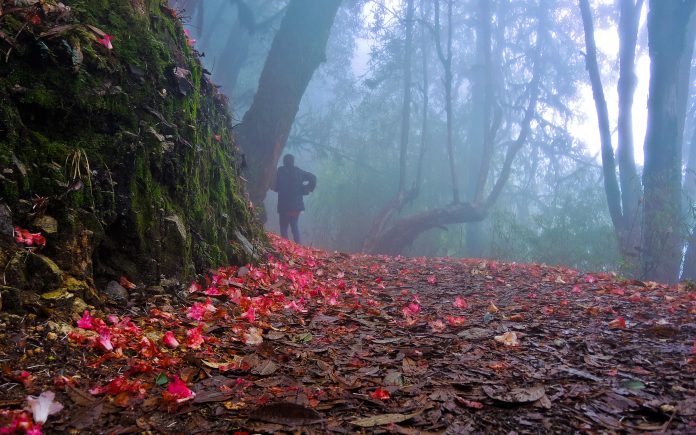By Journey Man
West Sikkim is peaceful and depicts the quiet lifestyle of the people. It is interesting to note how different sects of people from different areas have settled so harmoniously for ages. Yet, that is only the added attraction of a place full of beauty and peace. A visit to this place can bring out more from within you than you ever knew existed.
Like the rest of the state, this is also a tourist heaven. Here are some must-see places:
Gyalshing
The headquarters of the West district, Gyalshing, which means the King’s Garden, is believed to have once been the royal gardens attached to the Palace at Rabdentse, Sikkim’s capital till the late 18th century. Today it is a bustling town and the main transit point to various tourist destinations of the region. Close by is Rabdentse as well as Pemayangste, Sikkim’s premier monastery.
Opposite Gyalshing bazaar is the longest and believed to be the holiest, Mendang or Holy Wall, constructed by the third king, Chogyal Chador Namgyal. About 10km away from Pelling or a town before one arrives at Pelling is Gyalshing also known as Gyalshing Bazar, one of the oldest markets established approximately about 100 years ago.
This establishment was said to have been done under the initiative of the monk body of Pemayangtse monastery for the shopping comfort of the monks and public residing in the villages around Pemayangtse. Ever since Gyalshing market was established and first few shops were opened monks could do their monastic shopping and villagers could sell their village products like crops, dairy products, vegetables in the market and buy clothing and other household needs. Such trends sustain till today and as usual villagers gather every Sunday to do shopping or sell their products in Gyalshing Bazar.
Today the market is well equipped with shops of all kinds, multipurpose community hall, library, post office, banks, police stations, eating places, lodges, internet centers, taxi terminus and football ground. There are worshipping places for the people of all faith ‘Manilhagang’ where the meditation session for mostly the Buddhist women is organized every year during the holy occasion called Saga Dawa that falls in the month of June and Devithan for the Hindus, church and Masjid.
How to Reach
By Air – Nearby Airport Bagdogra
By Train – Nearby Rail Station New Jalpaiguri
By Road – SNT bus stoppage at Gyalshing
Varsey Rhododendron Sanctuary, Geyzing
Brimming with enchanting beauty, Varsey is a butterfly shaped rhododendron sanctuary that sprawls in a 104-sq-km area. It was declared a sanctuary in 1996. This wildlife attraction in Geyzing, Sikkim is known for its wide variety of rhododendron and several other species like Oak, Primula, Pine and Magnolia. The fauna that can be witnessed in the sanctuary includes Leopard cat, Himalayan Yellow Throated Marten, Himalayan Palm Civet, Himalayan Langur, Crimson Horned Pheasant, Monal Pheasant, Kaleej and many other species of birds. Situated on the Singalila Ridge, the view which the sanctuary offers of that of snowy peaks of Khangchendzonga is worth appreciating.
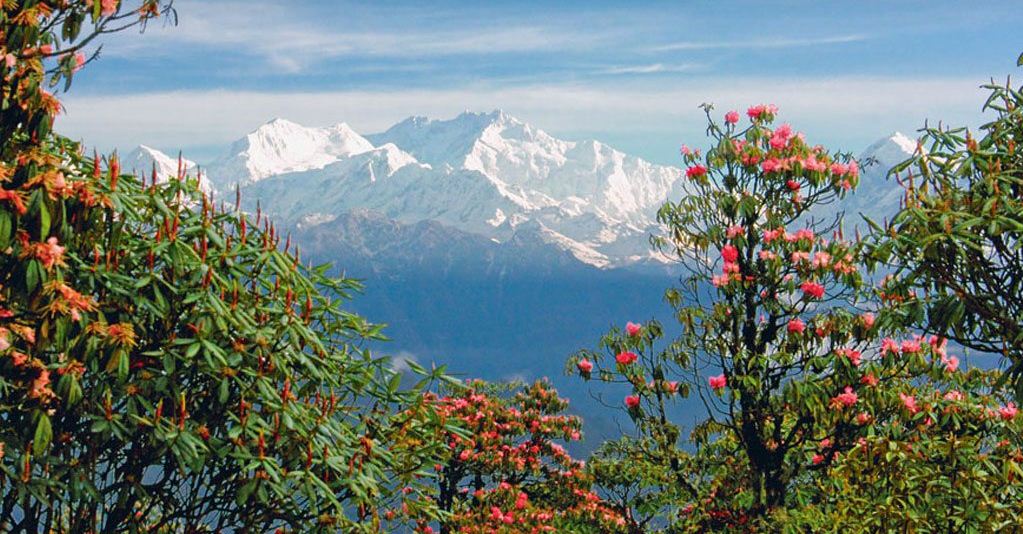

Varsey can be accessed from its three different gates, Hilley, Dentam and Soreng and is best explored on foot. During the walk towards the valley you may also see red pandas which are an endangered animal. The place’s natural essence certainly gives a welcoming vibe to the visitors.
Best Time To Visit
The best time to visit Varsey is during the months of October to May. However, April and May witness blooming of a wide variety of rhododendron flowers and make the ideal time to plan a visit here.
Getting there
Varsey is positioned in the western Sikkim area and taxis can be hired to reach this tourist place of interest from all major towns. Varsey is located 130 km from Gangtok, 95 km from Pelling and 70 km from Namchi.
Pemayangtse Monastery
It is one of the oldest monasteries of the state. It was originally established by Lhatsun Chempo, one of the revered Lamas to have performed the consecration ceremony of the first Chogyal (Monarch) of Sikkim. This ancient monastery belonging to the Nyingma Sect has been considered as one of the premier monasteries in the State. It has been entrusted with the task to perform all religious functions of the erstwhile monarch.
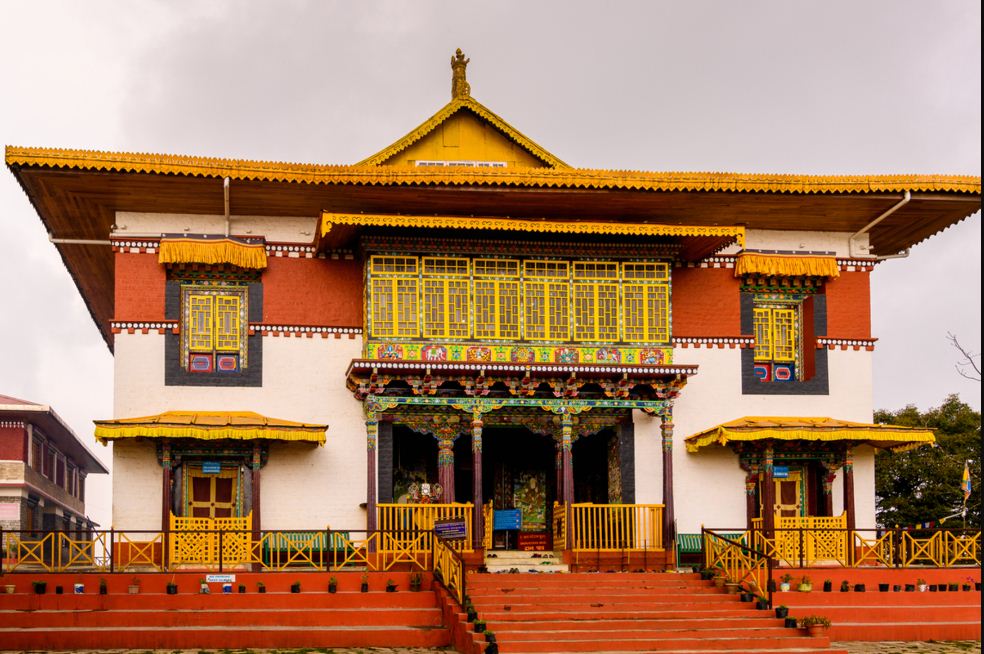

Pemayangtse Monastery was originally established as a high class monastery for ‘Pure Monks (Ta-Sang)’. Inside the monastery there is a wooden structure depicting the Maha Guru’s heavenly palace (Sang-tok-palri), which is considered a masterpiece created by Dungzin Rimpoche. The Monastery, located on a hill top at an altitude of 6,300 ft. commands a magnificent panoramic view of the Himalayan ranges, the surrounding hills and the countryside. A well furnished PWD Guest House is located just across the Monastery on a small hill top.
How to Reach
By Air – Nearby airport Bagdogra
By Train – Nearby Rail Station New Jalpaiguri
By Road – Nearby bus stoppage at Pelling
Yuksom
33 km from Pelling, Yuksom, literally meaning the ‘meeting place of three lamas’ is of great historical importance to the Sikkimese. It was here that the first Chogyal was crowned in 1642. The throne made of stones is even today considered sacred as is the footprint of Lhatsun Chenpo, which can be seen close to the throne. 2 km uphill from Yuksom is Dubdi monastery, the oldest in Sikkim.
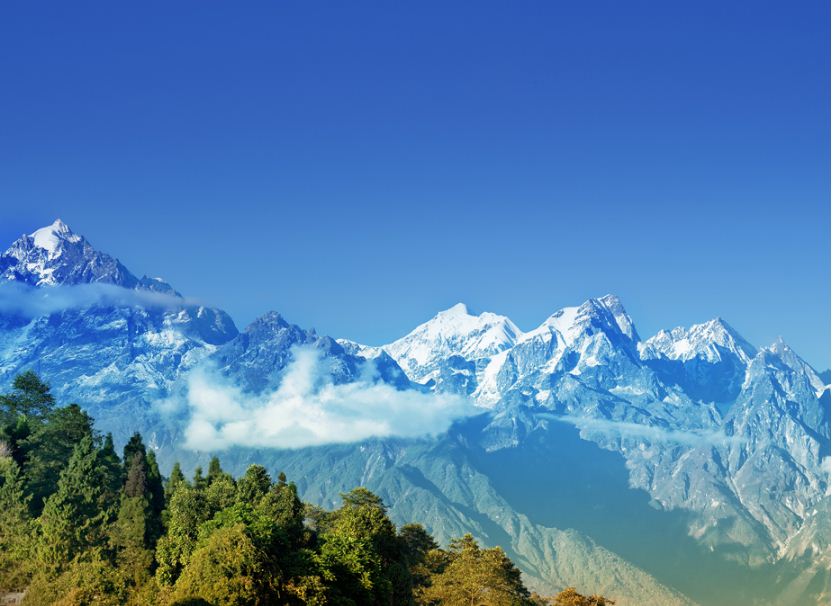

The monastery has now been declared a National Monument and is under the protection of the Archaeological Survey of India Yuksom today is an attractive tourist destination offering various stay options for the visitors including village home stays, where you can stay as part of a local family and imbibe the real Sikkimese way of life. Also available is a trekkers’ hut plus many lodges. Yuksom is also the gateway to the Khangchendzonga Biosphere Reserve, the base for some of the most fascinating treks through the high mountain region with the route to Dzongri being the most frequented.
How to Reach
By Air – Nearby airport Bagdogra
By Train – Nearby Rail Station New Jalpaiguri
By Road – 45 km from Gyalshing, a regular taxi services available from District HQ
Khecheopalri Lake, Pelling
As the prayer flags flutter in the wind and the calming sounds of bells ring one after the other, you know you have your bliss at the Khecheopalri Lake, which is a sacred pilgrimage site, considered holy by both Buddhist and Hindu. This religious place is believed to fulfil one’s wishes. The legend has it, if someone prays and sprinkles the water on oneself, his wishes are likely to come true. It is also said that no leaves can be seen afloat the lake despite being located amidst dense forest as the birds remove the fallen leaves from the water. Similarly, many legends revolve around the lake. A beautiful place, Khecheopalri Lake is a paradise for nature lovers and trekkers. There are various trekkers’ outlets and lodging facilities as well if you prefer camping overnight.
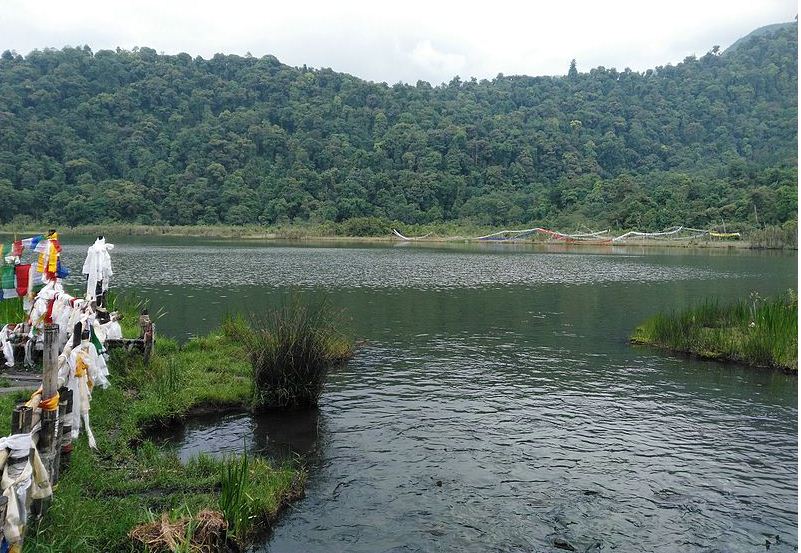

Best Time to Visit
The best time to visit this attraction is from February to March, when the weather remains quite pleasant.
Getting There
Khecheopalri Lake is located 34 km from Pelling and 147 km from Gangtok. Taxis are available to reach this attraction from these places. One has to get down at a point from where a trek for 5 hours begins.
Kirateshwar Mahadev Temple
Positioned amid emerald forests and on the edges of the glittering River Rangit, Kirateshwar Mahadev Temple is a renowned Hindu pilgrimage site. It is said that whoever prays at this temple, all his wishes come true if you pray whole-heartedly. However, the temple is also widely visited because the premises houses three separate platforms to pray to Goddess Durga, Lord Rama and Lord Shiva. It is said that Kirateshwar Mahadev is the oldest temple in the state.
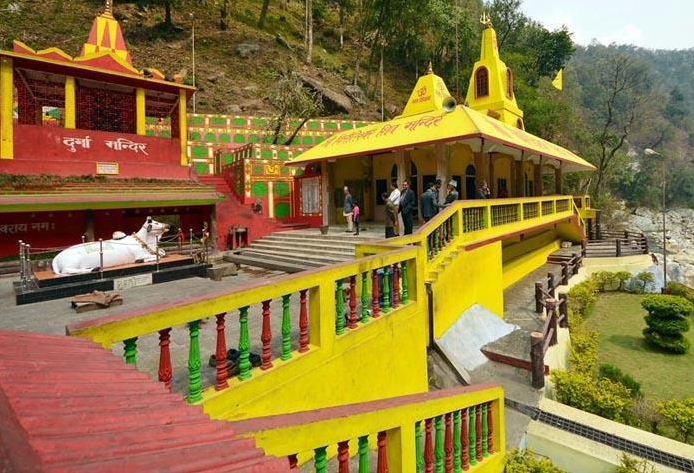

This sacred temple is also mentioned in the Mahabharata because of its vital role in the epic battle. The main attraction the temple is known for is the festival of the Bala Chaturdashi which takes place in November – December every year. And also Maha Shivaratri, this festival falls in the month of February or March and many devotees from near and far come to attend this auspicious event.
Best Time To Visit
The best time to visit this temple is from February to May but if you are a devotee then you can visit during the festivals. Bala Chaturdashi is the first festival celebrated in November and December. This is followed by Shivaratri celebrated in February/March.
How to Reach
By Air – Nearby airport Bagdogra
By Train – Nearby Rail Station New Jalpaiguri
By Road – 16 km from Gyalshing. Nearby bus stop Legship bazaar
Rabdentse Ruins
Rabdentse was the second capital of the former Kingdom of Sikkim from 1670 to 1814. The capital city was destroyed by the invading Gurkha army and only the ruins of the palace and the chortens are seen here now. However, the ruins of this city are seen close to Pelling and in West Sikkim district in the Northeastern Indian state of present-day Sikkim; Pemayangtse Monastery is one of the oldest monasteries in Sikkim which is close to the ruins.
The Rabdentse ruins are part of Buddhist religious pilgrimage circuit starting with the first monastery at Yuksom known as the Dubdi Monastery, followed by Norbugang Chorten, Tashiding Monastery, the Pemayangtse Monastery, the Sanga Choeling Monastery, and the Khecheopalri Lake.
Today, the ruins lie hidden from the main road at a walking distance from the Pemayangtse Monastery. The scenic view from the top of the ruins scanning across the valley to the mystic heights of Khang-chen-Dzonga range is something to be cherished and etched in memory.
Best time to visit
During the summer season from March to May, the weather is exceptionally pleasant and the temperature ranges between 7°C to 28°C, which is quite bearable to move around and explore the place.
How to Reach
By Air – Nearby Airport Bagdogra
By Train – Nearby Rail Station New Jalpaiguri
By Road – 8 km from Gyalshing
HISTORY
The West District has an Administrative District, as its beginning only from 1963 before that it was a part of West Zone (region) as Sikkim State was divided in two administrative zones – East zone and West zone. Every zone was under the control of Revenue Officer appointed by Chogyal (the then king) of Sikkim and the administration of justice was in the hand of Tribal Authority like Zonepal at the district, Zone level, Yaplas Feudal Landlord, Pipon (head men), Mandal head etc. The revenue of the land used to be collected and augmented by the Yaplas to deposit in state khazana which was most of the time in terms of food grain and some agriculture based articles.
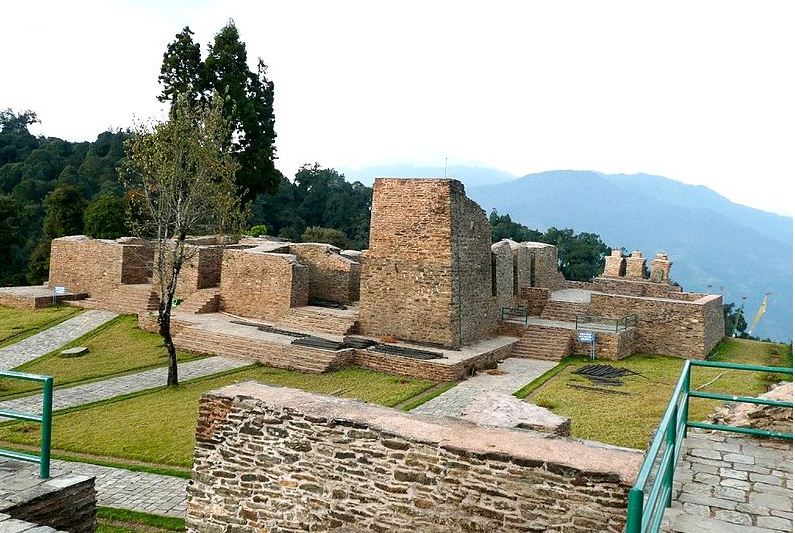

The concept of district, first time appeared only in the year 1963 when East zone was bifurcated from the East and North District and the West zone was in West District and the South District. Hence the West District came into existence as a modern administrative district only in 1963 by an order of the king on April 1, 1963 and R.B. Mukhia was appointed as first District Officer of the West District. The District Officer was given all administrative power on behalf of the king though the authority of Zonepal and Yaplas was still prevailing.
In 1972 the term District Collector was used first time for the District Officer P.K. Pradhan is believed to be first District Collector of West District. After the merger of Sikkim in India the District Collector was designated as District Magistrate and the District Collector was conferred with the powers provided in criminal procedures of 1898.
Demography
Area 116600 Hectares
Population 136,435 (2011 census)
Temperature Max : 17– 27 degree C; Min : 02 – 21 degree C
Annual Rainfall 162.5 cm
Seasonal Clothing Summer – Light cotton, Winter – Woollens Rainy – Warm light cotton
No of Sub Division 4
No. of Towns 2
DEMOGRAPHY
People & Culture
Communities, Cultures, Religions and Customs of different hues intermingle freely here in Sikkim to constitute a homogeneous blend.
The predominant communities are the Lepchas, Bhutias and Nepalese. In urban areas, many plainsmen have also settled and they are almost engaged in business and Government service. Because of the development activities in the state, like the construction of roads, bridges and buildings a small part of the population consists of migrant labourers from the plains and Nepal.
The Lepchas
The Lepchas said to be aborigines of Sikkim are of mongoloid descent. There are different theories regarding the origins of Lepchas. The most widely accepted theory relating to their origin is that the Lepchas are originated from Sinotar Plateau of Burma (Myanmar). The major concentration of Lepchas can be found in Dzongu in north district and Dikchu in east Sikkim, Rinchenpong in west Sikkim and several other parts. In order to preserve this fast vanishing tribe, the Chogyal had declared Dzongu as a Lepcha reserve.
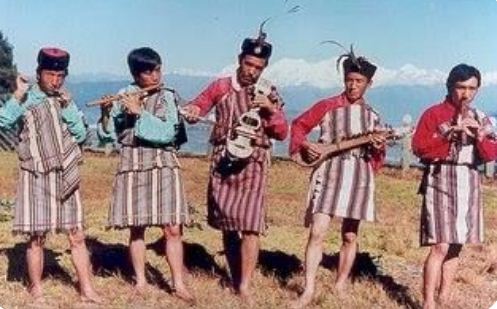

Non Lepchas were thus barred from settling there. Before adopting Buddhism or Christianity as their religion, the earliest Lepcha settlers were believers in the bon faith or mune faith, which is based on spirits, witchcraf, exorcism and nature worship. Hence, Lepchas are shy and quiet in nature, prefer living in complete harmony with nature and its natural surroundings. One of the important deities of the Lepchas, Tamsangthing is said to have invented the rich Lepcha script.
Life in a Lepcha dwelling is very simple. The male Lepcha wears a dress called a “pagi” made of cotton, which is striped. The female Lepcha wears a two piece dress. The Lepchas speak the language Lepcha, although this language is not very well developed but is rich in vocabulary related to the flora & fauna of Sikkim. Lepchas are very good at archery. The polyandry marriages are permitted amongst the Lepchas.
The Bhutias
The Bhutias are believed to have originally come from the Kham area of Tibet, by following prince Khey Bhumsa. They are evenly distributed throughout the state of Sikkim. In northern Sikkim where they are the major inhabitants, they are known as the Lachenpas and Lachung Pass and they inhabit the areas around Lachen and Lachung, respectively, having their own traditional legal system known as ‘Zumsa’ and with its legal head ‘pipon’. The Bhutia aristocrats are known as the Kazis.
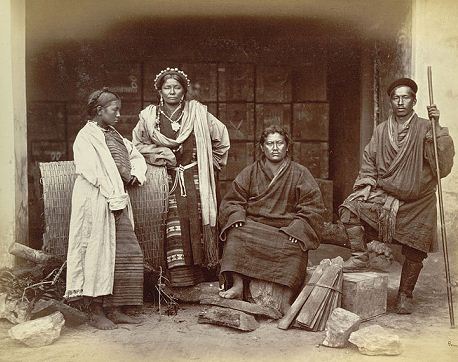

The Language spoken by Bhutia is Sikkimese which is in fact a dialect of Tibetan language and has the same script as Tibetans. They love festivities, songs and music and have an impressive tradition of handloom and handicraft.
The traditional dress of the male member is known as the “Bakhu” which is a loose cloak type garment with full sleeves. The ladies dress consists of a silken “Honju” which is a full sleeve blouse and a loose gown type garment. The ladies are very fond of heavy jewellery made of pure gold.
The Nepalese
The Nepalese now constitute more than 80% of the total population of Sikkim considerably out numbering the Lepchas and the Bhutias. The majority community of Nepalis began coming to Sikkim somewhere in the 1860s with the then ruler of Sikkim granting a lease in Sikkim to some Nepali traders. Due to their adjusting nature and hard work, the Nepali settlers introduced the terraced system of cultivation and this brought large tracts of hilly terrain to yield crops productivity.
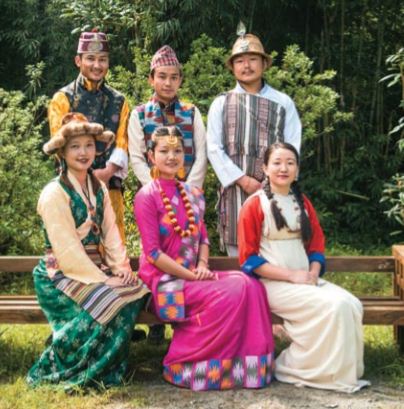

Major sub-cultural stocks of the Nepalese are the Kiratis who along with the Lepchas are said to be the aborigines of Sikkim. Some of the major Nepali social groups are Limboo, Tamang, Gurung, Newar, Mangar, Sunwar etc. The language spoken by the Nepalis are Nepali and have the Devanagri script. The Nepali language is also used as the common language spoken for interaction by every community. Majority of the Nepalis are devout Hindus. They have fabulous art, cultural traditions, folklore, legends, rituals, beliefs and practices.

